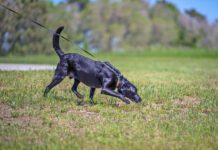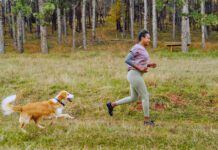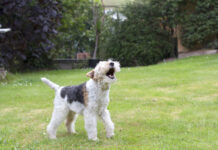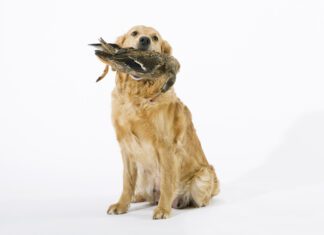Human-dog interactions can be more difficult than dog-dog ones, since our native languages are so different. Our series of three photos this month depicts a classic conflict between a canine and a human; the two are strangers and neither really understands what the other is communicating. Similar interactions are played out every day in communities across the country, in which well-intentioned humans do all the wrong things in their efforts to be friendly with dogs. Far too often, the failure of dog and human to understand each other and respond appropriately results in a bite – or several.
Last month, we ran photos of an interaction between a human and a dog. Did you spot signs of their mutual misunderstanding?
———-
PHOTO #1 ANALYSIS

288
• Man – The man is bent over from the waist, directly facing the strange dog, making direct eye contact. He has observed the dog growling and barking at him, and he’s probably saying something like, “Here, boy!”
• Dog – Tail is stiffly erect, ears appear pricked forward, commisure (corner of lips) looks forward, body posture is tall and forward, and the dog is also making direct eye contact.
CONCLUSION
The man would like to meet and greet the dog, and is using appropriate primate body language to do so.
Bending at the waist is a human invitation to come closer. In our culture, a face-front greeting that includes direct eye contact indicates honesty, friendliness, and sincerity. The man is doing his best to entice the dog to come see him.
However, in the canine world, a full-front, bent-forward posture with direct eye contact is a strongly assertive threat, and the dog is reacting accordingly with defensive aggression. He may not be sure what the man is up to, but he’s sure he wants no part of it!
———-
PHOTO #2 ANALYSIS

288
• Man – Our human has straightened to full height and is stepping forward, still maintaining direct eye contact with the dog.
• Dog – Has moved off to the side, still carrying his tail high and maintaining direct eye contact with the man. His ears are pricked and his mouth appears puckered forward. It’s hard to tell for certain because of the angle, but his body posture still appears tall and forward.
CONCLUSION
The man has recognized that the dog is rejecting his advances, and is choosing to walk on. He has properly interpreted the dog’s aggressive posturing and has wisely given up making friends. While the human’s upright posture is less of a threat to the dog than his bent-over position in Photo #1, he is still making direct eye contact. The stick in his right hand is raised slightly. I’m curious as to whether he’s aware he did this – if he made this defensive gesture consciously, or if it was an automatic self-protection response.
The dog is still clearly aroused – keeping his eye on the man and his defenses up to see if the dangerous human poses any further threat.
———-
PHOTO #3 ANALYSIS
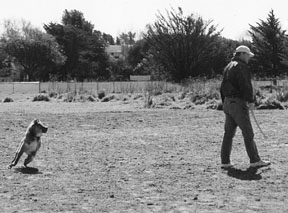
288
• Man – Has ceased interaction with the dog; walks forward, stick still slightly raised.
• Dog – In contrast, the dog continues to engage. He has circled behind the man and continues to show tension in his markedly forward posture, intense stare, and sharply pricked ears.
CONCLUSION
While the man appears to have dismissed the unfriendly dog and moved on, the dog isn’t yet done with this once-threatening human. Actually, the man is probably at the greatest risk at this moment in the interaction; defensively aggressive dogs are most likely to bite from behind or if cornered, and this dog looks likely to run up behind the man for a stealth attack. Something about the man’s posture suggests he may be more aware of the potentially threatening dog than it seems at first glance. Perhaps he belatedly realized that his eye contact was exacerbating the dog’s aggression.
Fortunately, this interaction ended without a bite. The man’s decision to break eye contact and move on worked. If he’s ever in a similar situation again, it might be wiser to stand still, turning slowly if necessary to keep his eye on the dog without making strong direct eye contact, until the dog relaxes and leaves or relaxes enough that the man can leave more safely.



